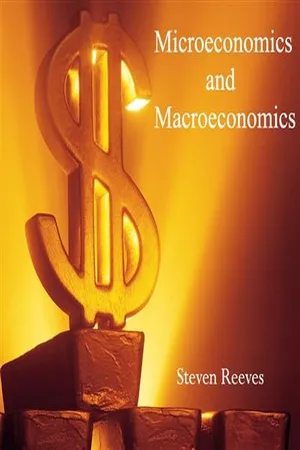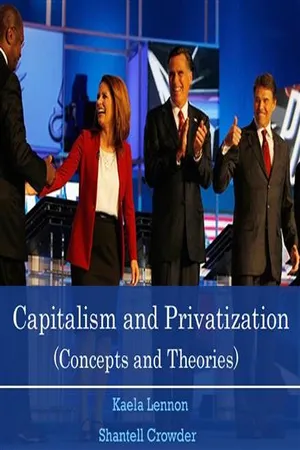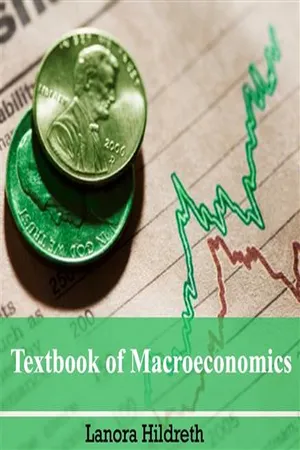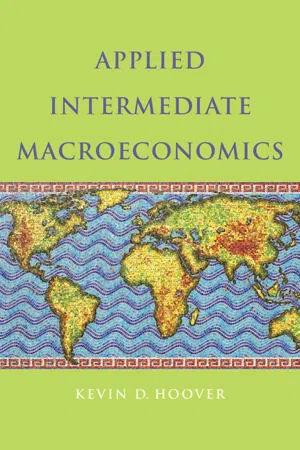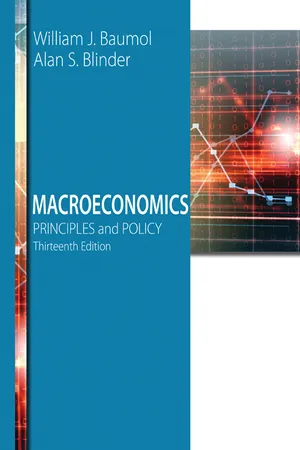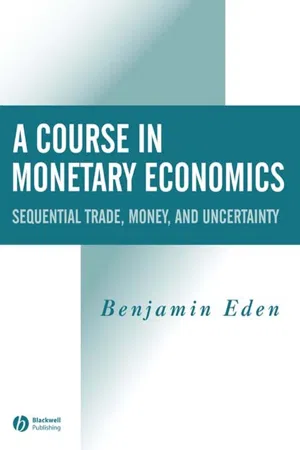Economics
Monetary Policy Curve
The monetary policy curve represents the relationship between the interest rate and the level of economic activity. It illustrates how central banks adjust interest rates to influence economic growth and inflation. As interest rates rise, borrowing becomes more expensive, leading to reduced spending and economic activity, while lower interest rates can stimulate economic growth.
Written by Perlego with AI-assistance
Related key terms
1 of 5
11 Key excerpts on "Monetary Policy Curve"
- No longer available |Learn more
- (Author)
- 2014(Publication Date)
- Orange Apple(Publisher)
Various states in the United States have various forms of self-imposed fiscal straitjackets. Monetary Policy Monetary policy is the process by which the monetary authority of a country controls the supply of money, often targeting a rate of interest to attain a set of objectives oriented towards the growth and stability of the economy. These goals usually include relatively stable prices and low unemployment. Monetary theory provides insight into how to craft optimal monetary policy. Monetary policy is referred to as either being an expansionary policy, or a contractionary policy, where an expansionary policy increases the total supply of money in the economy rapidly, and a contractionary policy decreases the total money supply, or increases it slowly. Expansionary policy is traditionally used to combat unemployment in a recession by lowering interest rates, while contractionary policy involves raising interest rates to combat inflation. Monetary policy is contrasted with fiscal policy, which refers to government borrowing, spending and taxation. Overview Monetary policy rests on the relationship between the rates of interest in an economy, that is, the price at which money can be borrowed, and the total supply of money. Monetary policy uses a variety of tools to control one or both of these, to influence outcomes like economic growth, inflation, exchange rates with other currencies and unemployment. Where currency is under a monopoly of issuance, or where there is a regulated system of issuing currency through banks which are tied to a central bank, the monetary authority has the ability to alter the money supply and thus influence the interest rate (to achieve policy goals). The beginning of monetary policy as such comes from the late 19th century, where it was used to maintain the gold standard. A policy is referred to as contractionary if it reduces the size of the money supply or increases it only slowly, or if it raises the interest rate. - No longer available |Learn more
- (Author)
- 2014(Publication Date)
- Library Press(Publisher)
____________________ WORLDTECHNOLOGIES ____________________ Chapter- 4 Monetary Policy Monetary policy is the process by which the monetary authority of a country controls the supply of money, often targeting a rate of interest for the purpose of promoting economic growth and stability. The official goals usually include relatively stable prices and low unemployment. Monetary theory provides insight into how to craft optimal monetary policy. Monetary policy is referred to as either being expansionary or contractionary, where an expansionary policy increases the total supply of money in the economy more rapidly than usual, and contractionary policy expands the money supply more slowly than usual or even shrinks it. Expansionary policy is traditionally used to try to combat un-employment in a recession by lowering interest rates in the hope that easy credit will entice businesses into expanding. Contractionary policy is intended to slow inflation in hopes of avoiding the resulting distortions and deterioration of asset values. Monetary policy differs from fiscal policy, which refers to taxation, government spending, and associated borrowing. Overview Monetary policy rests on the relationship between the rates of interest in an economy, that is, the price at which money can be borrowed, and the total supply of money. Monetary policy uses a variety of tools to control one or both of these, to influence outcomes like economic growth, inflation, exchange rates with other currencies and unemployment. Where currency is under a monopoly of issuance, or where there is a regulated system of issuing currency through banks which are tied to a central bank, the monetary authority has the ability to alter the money supply and thus influence the interest rate (to achieve policy goals). The beginning of monetary policy as such comes from the late 19th century, where it was used to maintain the gold standard. - No longer available |Learn more
- (Author)
- 2014(Publication Date)
- College Publishing House(Publisher)
____________________ WORLD TECHNOLOGIES ____________________ Chapter- 4 Monetary Policy Monetary policy is the process by which the monetary authority of a country controls the supply of money, often targeting a rate of interest for the purpose of promoting economic growth and stability. The official goals usually include relatively stable prices and low unemployment. Monetary theory provides insight into how to craft optimal monetary policy. Monetary policy is referred to as either being expansionary or contractionary, where an expansionary policy increases the total supply of money in the economy more rapidly than usual, and contractionary policy expands the money supply more slowly than usual or even shrinks it. Expansionary policy is traditionally used to try to combat unemployment in a recession by lowering interest rates in the hope that easy credit will entice businesses into expanding. Contractionary policy is intended to slow inflation in hopes of avoiding the resulting distortions and deterioration of asset values. Monetary policy differs from fiscal policy, which refers to taxation, government spending, and associated borrowing. Overview Monetary policy rests on the relationship between the rates of interest in an economy, that is, the price at which money can be borrowed, and the total supply of money. Monetary policy uses a variety of tools to control one or both of these, to influence outcomes like economic growth, inflation, exchange rates with other currencies and unemployment. Where currency is under a monopoly of issuance, or where there is a regulated system of issuing currency through banks which are tied to a central bank, the monetary authority has the ability to alter the money supply and thus influence the interest rate (to achieve policy goals). The beginning of monetary policy as such comes from the late 19th century, where it was used to maintain the gold standard. - No longer available |Learn more
- (Author)
- 2014(Publication Date)
- White Word Publications(Publisher)
____________________ WORLD TECHNOLOGIES ____________________ Chapter-8 Monetary Policy Monetary policy is the process by which the monetary authority of a country controls the supply of money, often targeting a rate of interest for the purpose of promoting economic growth and stability. The official goals usually include relatively stable prices and low unemployment. Monetary theory provides insight into how to craft optimal monetary policy. Monetary policy is referred to as either being expansionary, or a contractionary, where an expansionary policy increases the total supply of money in the economy more rapidly than usual, and a contractionary policy expands the money supply more slowly than usual or even shrinks it. Expansionary policy is traditionally used to try to combat unemplo-yment in a recession by lowering interest rates in the hope that easy credit will entice businesses into expanding. Contractionary policy is intended to slow inflation in hopes of avoiding the resulting distortions and deterioration of asset values. Monetary policy is contrasted with fiscal policy, which refers to: taxation, government spending, and associated borrowing. Overview Monetary policy rests on the relationship between the rates of interest in an economy, that is, the price at which money can be borrowed, and the total supply of money. Monetary policy uses a variety of tools to control one or both of these, to influence outcomes like economic growth, inflation, exchange rates with other currencies and unemployment. Where currency is under a monopoly of issuance, or where there is a regulated system of issuing currency through banks which are tied to a central bank, the monetary authority has the ability to alter the money supply and thus influence the interest rate (to achieve policy goals). The beginning of monetary policy as such comes from the late 19th century, where it was used to maintain the gold standard. - Thomas F. Cargill(Author)
- 2017(Publication Date)
- Cambridge University Press(Publisher)
Monetary policy can move the economy along a given 314 Chapter 14. Step 4: The Central Bank Model of the Economy short-run Phillips curve (from point A to B in Figures 14.4 and 14.6 ), but, once inflationary expectations are adjusted to the changed inflation rate, the economy returns to its natural long-run equilibrium (from point B to C in Figures 14.4 and 14.6 ). That is, monetary, fiscal and other policies to change aggregate demand can be nonneutral only in the short run, but they are neutral in the long run. There is no Phillips curve tradeoff between inflation and economic activity that can be exploited by stabilization policy. Third, the new Phillips curve indicates that the only reasonable final policy tar-get for monetary policy (Step 5) is price stability. In the long run, central banks should focus their attention on the inflation rate, because there is a long-run rela-tionship between monetary growth and inflation, and the central bank is unable to change the natural equilibrium of the economy. NUN and PGDP are depen-dent on real fundamentals and can be influenced only by institutional changes that improve the efficiency of the economy, technology, capital accumulation, changes in the composition of the labor force and changes in labor productivity. That is, asking central banks to achieve additional objectives to influence real economic activity is counterproductive and interferes with their ability to achieve their pri-mary responsibility of long-run price stability. Another way to make the same point is that better monetary policy outcomes occur when central banks are less activist and focus instead on long-run price stability and being a lender of last resort on occasion. The first two implications of the new Phillips curve are widely accepted; how-ever, debate over the third continues.- eBook - PDF
- D. Mayes, Matti Virén(Authors)
- 2011(Publication Date)
- Palgrave Macmillan(Publisher)
174 8 Monetary Policy Monetary policy is probably the most obvious area of policy where behaviour is likely to be asymmetric or at any rate nonlinear. We can see this from four directions. The first is that since the Phillips curve is nonlinear as set out in Chapter 4, monetary policy acting through the IS curve, Chapter 3, will have a different effect depending on whether the output gap is positive or negative. If the output gap is positive then inflation is quite sensitive to the operation of policy. If the output gap is negative then policy is much less effective. Hence, we can expect that movements in interest rates will be more substantial in the face of the threat of deflation than in the case of excess inflation. Clearly the same applies to any other asymmetries in the operation of the economy, presuming that is that monetary policy is attempting to help hold the economy on a smooth track of low inflation and make a contribution to stable sustainable economic growth. Monetary policy needs to be asymmetric to try to offset some of the asymmetries in the economy. There is a second reason for the wish to act more vigorously in the down phase of the cycle, namely that except in special circumstances, nominal interest rates cannot be negative – the zero bound problem. While it is real interest rates that have the effect on the economy, in severe downturns, not only is output likely to fall but so are prices. Thus a zero nominal interest rate becomes a positive real rate, just at a time when the monetary authority might want to see negative rates. In the present crisis both the US and the UK have attempted to get round the zero bound, as did the Japanese in the 1990s by expanding the money supply so as to create the expectation of future inflation. It is still being debated whether this is effective but, whatever the conclu- sion, the effect is clearly far from symmetric. Thirdly, monetary policy targets themselves tend to have a nonlinear element to them. - eBook - PDF
- Manzur Rashid, Peter Antonioni(Authors)
- 2015(Publication Date)
- For Dummies(Publisher)
To understand monetary policy you need to understand how the money market works, how the central bank can in effect choose the interest rate by varying the money supply and how it achieves this aim in practice. Luckily, we cover exactly these topics in this section! Taking a stall at the money market The money market is like any other market in that the price is determined by supply and demand. Things can get a little confusing, though, because you may be thinking: sure, a certain car or house can have a particular price, but how can money have a ‘price’? Isn’t money just money? The price of money is the interest rate: or more precisely, the nominal inter‑ est rate (we compare the meaning of nominal versus real in Chapter 2). Cash is the most liquid of assets, which means that you can easily convert it into goods and services. But when you hold cash, you give up the return that you could get by holding a less liquid asset (say, government bonds or a savings account). Thus the opportunity cost of holding cash is the return on govern‑ ment bonds/savings account – that is, the nominal interest rate. So, if the nominal interest rate is 2 per cent, by holding cash you’re effectively paying 2 per cent per year for the liquidity. At high interest rates the demand for money tends to be low, whereas at low interest rates the demand for money is relatively high, because holding cash is very costly (in terms of opportunity cost) when the interest rate is high. That is, people hold only as much cash as is necessary to get them through the next few days (or even hours). Conversely, when interest rates are low, holding cash isn’t that costly and people demand relatively a lot of it. 165 Chapter 10: Using Monetary Policy to Influence the Economy Bearing in mind that the central bank controls the money supply, equilibrium in the money market occurs when the quantity of money demanded is exactly equal to the quantity of money the central bank supplies. - eBook - PDF
- Kevin D. Hoover(Author)
- 2011(Publication Date)
- Cambridge University Press(Publisher)
16.5 The Conduct and Limits of Monetary Policy 16.5.1 The Goals of Monetary Policy Inflation and Employment The Humphrey-Hawkins Act of 1978 requires that the Fed pursue a pol-icy aimed at securing “maximum employment, stable prices, and moderate long-term interest rates.” The Fed’s legal mandate is a difficult one. The monetary policymaker is rather like Cinderella trying to satisfy the impos-sible demands of her stepsisters: “Go up into the attic, go down into the cellar – you can do them both together, Cinderella.” If unemployment is the 16.5 The Conduct and Limits of Monetary Policy 649 Fed’s cellar and inflation its attic, the Phillips curve assures our monetary-policy Cinderella that she cannot do them both together. The Fed’s problem may be even more difficult than having to decide the most desirable trade-off between inflation and unemployment. Most economists believe that, in the long run, monetary policy (and aggregate-demand policies generally) can affect only inflation, and not output, employ-ment, or other aspects of the real economy. In Chapter 13 (section 13.4), we saw that an economy cannot be pushed past full employment, although full employment may imply a measured unemployment rate less than NAIRU. Once at full employment, further growth is possible (as we saw in Chapters 9 and 10) only if the capital stock or labor force grows or technology improves. Barring that, an expansionary monetary policy (as we saw in Figure 16.8 ) must be absorbed by higher prices. Some economists go further and argue that monetary policy mainly affects inflation even in the short run. They often point to the 1960s and 1970s as evidence. Then, they say, the Federal Reserve tried to push the unemploy-ment rate below NAIRU. Inflation accelerated and, because of unfavorable supply shocks, real output actually fell. The result was stagflation. This argument makes two key assumptions. - eBook - PDF
Macroeconomics
Principles and Policy
- William Baumol, Alan Blinder(Authors)
- 2015(Publication Date)
- Cengage Learning EMEA(Publisher)
But a central bank can use a model similar to the aggregate supply/demand model taught in this book to estimate how its policy choices will affect the unemployment rate, say, this year and next. Then it can use a Phillips curve to estimate how that unemployment path will affect inflation. In fact, that is more or less what inflation-targeting central banks from New Zealand to Norway now do. Inflation Targeting and the Phillips Curve JEWEL SAMAD/Getty Images slowly to unemployment, the costs of waiting may be enormous—which is how things have looked to most U.S. policy makers in the years since 2008. The efficacy of the self-correcting mechanism is also surrounded by controversy. Most economists believe that the weight of the evidence points to extremely sluggish wage behav-ior: Wage inflation appears to respond slowly to economic slack. In terms of Figure 9 , this lag means that the economy will traverse the path from a to c at an agonizingly slow pace, so that a long period of weak economic activity will be necessary to bring down inflation. But a significant minority opinion finds this assessment far too pessimistic. Economists in this group argue that the costs of reducing inflation are not nearly so severe and that the key to a successful anti-inflation policy is how it affects people’s expectations of inflation. To understand this argument, we must first understand why expectations are relevant to the Phillips curve. 17-7 INFLATIONARY EXPECTATIONS AND THE PHILLIPS CURVE Recall from Chapter 10 that the main reason the economy’s aggregate supply curve slopes upward—that is, why output increases as the price level rises—is that busi-nesses typically purchase labor and other inputs under long-term contracts that fix input costs in money terms. (The money wage rate is the clearest example.) As long as such contracts are in force, real wages fall as the prices of goods rise. - eBook - PDF
Economics for Investment Decision Makers
Micro, Macro, and International Economics
- Christopher D. Piros, Jerald E. Pinto(Authors)
- 2013(Publication Date)
- Wiley(Publisher)
We demonstrated earlier how a central bank can manipulate the money supply and growth of the money supply. We also indicated how policy rates set and targeted by the central banks are usually very short- term in nature; often they target overnight interest rates. However, most businesses and individuals in the real economy borrow and lend over much longer time frames than this. It may not be obvious, then, how changing short-term interest rates can influence the real economy, particularly if money neutrality holds in the long run. The fact that central bankers believe that they can affect real economic variables, in particular economic growth, by influencing broad money growth suggests that they believe that money is not neutral—at least not in the short run. Exhibit 7-7 presents a stylized representation of the monetary transmission mechanism. This is the process whereby a central bank’s interest rate gets transmitted through the economy and ultimately affects the rate of increase of prices—that is, inflation. Suppose that a central bank announces an increase in its official interest rate. The implementation of the policy may begin to work through the economy via four interrelated channels. Those channels include bank lending rates, asset prices, agents’ expectations, and 356 Economics for Investment Decision Makers exchange rates. First, as described earlier, the base rates of commercial banks and interbank rates should rise in response to the increase in the official rate. Banks would, in turn, increase the cost of borrowing for individuals and companies over both short- and long-term horizons. Businesses and consumers would then tend to borrow less as interest rates rise. An increase in short-term interest rates could also cause the prices of such assets as bonds or the value of capital projects to fall as the discount rate for future cash flows rises. - eBook - PDF
A Course in Monetary Economics
Sequential Trade, Money, and Uncertainty
- Benjamin Eden(Author)
- 2008(Publication Date)
- Wiley-Blackwell(Publisher)
PART I Introduction to Monetary Economics 1 Overview 2 Money in the Utility Function 3 The Welfare Cost of Inflation in a Growing Economy 4 Government 5 More Explicit Models of Money 6 Optimal Fiscal and Monetary Policy 7 Money and the Business Cycle: Does Money Matter? 8 Sticky Prices in a Demand-satisfying Model 9 Sticky Prices with Optimal Quantity Choices 10 Flexible Prices 3 In the first part of this book we use standard monetary models to talk about the joint behavior of nominal and real variables. We start with the long-run relationship focusing on the relationship between money and inflation. The focus then shifts to the short-run relationship between money and output. Special attention is devoted to the choice of fiscal and monetary policy. This introductory part sets the stage for a less standard approach in the third part of the book. CHAPTER 1 Overview Monetary economics is about the relationship between real and nominal variables. Its aim is to develop and test models that can help in evaluating the effects of policy on inflation, employment, nominal and real interest rates and production. We start with some evidence on the relationship between nominal and real variables and then describe some of the questions that occupy monetary economics. 1.1 MONEY, INFLATION, AND OUTPUT: SOME EMPIRICAL EVIDENCE In his Nobel lecture Lucas (1996) summarizes the long-run effects of changes in the money supply with the aid of two figures, taken from McCandless and Weber (1995). These figures are reproduced here. Figure 1.1 plots 30-year (1960–90) average annual inflation rates against average annual growth rates of M2 (currency + demand deposits + time deposits) over the same 30-year period, for a total of 110 countries. Figure 1.2 has the growth of real output on the vertical axis. We see a high correlation between average money growth and average inflation but no correlation between average money growth and average real growth.
Index pages curate the most relevant extracts from our library of academic textbooks. They’ve been created using an in-house natural language model (NLM), each adding context and meaning to key research topics.
